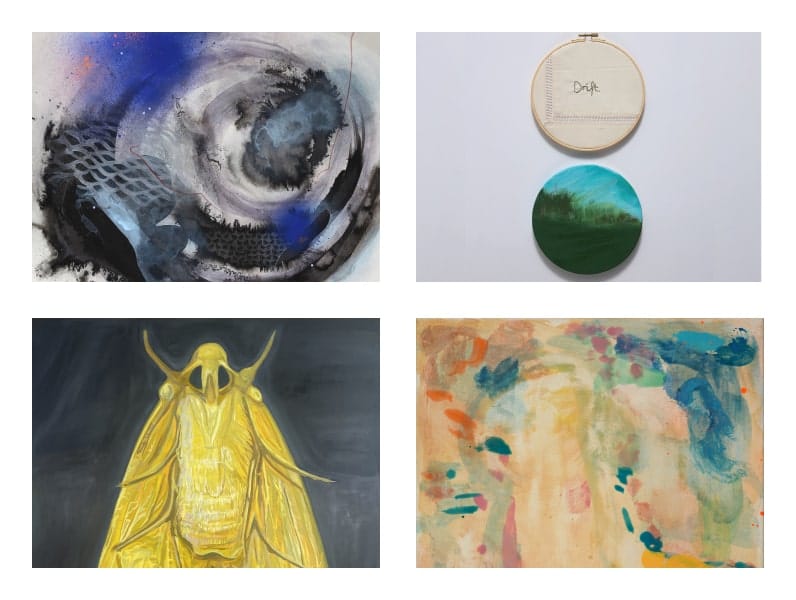
- This event has passed.
Gang of 4 – Contemporary Approaches to Landscape Painting
6 Sep, 2025 - 19 Sep, 2025
Free
Open Wednesday – Sunday (11am – 5pm)
We are four painters. We are all inspired by and respond to the idea of landscape in different ways. It is a constant. A thread running through our artistic practices which joins us together for this exhibition.
Jenny Mason works with paint, textiles, text, and found objects in her practice. She is based in Edinburgh but spends as much time as possible immersed in wilder landscapes, running or sea swimming. Through these physical activities she gains a calmness and clarity. For her, immersion in the landscape frees the mind up; she can let thoughts come up, without effort, often writing notes in response to a swim or on completion of a run. The works displayed in this exhibition were made in response to various lakes, places, swims, and runs. Diptychs combining landscape paintings with embroidered text from her notes, sharing with the viewer both a sense of place, and of the feelings she had when immersed in it.
Gemma Petrie is a watercolour painter based in the Highlands. She uses the innate qualities of watercolour in combination with drawing materials to create abstracted figurative and biomorphic works using symbols, motifs, colours, and patterns from everyday life, the landscape that she is immersed in, and moments from the past. She focuses on the surface of our environment, how it holds the past, present and future simultaneously. Her work considers what our place is within this space.
Adrian Gardner’s paintings explore how we experience and make sense of the world, contrasting between the modern and mythological beliefs regenerated in the now. Ancient Greeks believed the soul travelled along the river Acheron to the underworld, and in many of his works he imagines this journey. The fragility of nature, surface beauty, tragedy lurking not far beneath. His work often references nature, off grid, from a perspective of memento mori, celebrate, enjoy and protect what we have inherited before it is gone. This feeling of impending doom, like the Greek tragedy, permeates the work, although colourful and pretty at face value, suggests a transition to an uncertain realm or future
Michael Clarence’s paintings themselves have become landscapes, though not in the literal or traditional sense. Their geographical impetus and inspiration cannot be disconnected from their becoming—both are symbiotic. Over the past ten years, place and its physical incarnation (landscape) have been instrumental in shaping much of his practice and enacting change upon it. The surfaces of the paintings carry traces of erosion and human intervention, where constructions and destructions are made visible to the viewer, reflecting the continual processes of transformation in both landscape and painting. Landscape has the power to be all of this, to enact change in the same way we inflict change upon it, and a constant reassertion of forces must take place, necessary adjustments to mitigate and temper our human impact. While it is hard not to think of landscape in a Western sense as something to be visualised and dominated, Michael is drawn to approaches that mirror Eastern philosophies of attentiveness and presence, where the landscape—or painting—is not possessed, but experienced. These works are spaces to inhabit, topographies of past action, incarnations of landscape, landscapes of a journey taken, where one attempts to make the metaphysical manifest within the two-dimensional surface of the picture plane.
